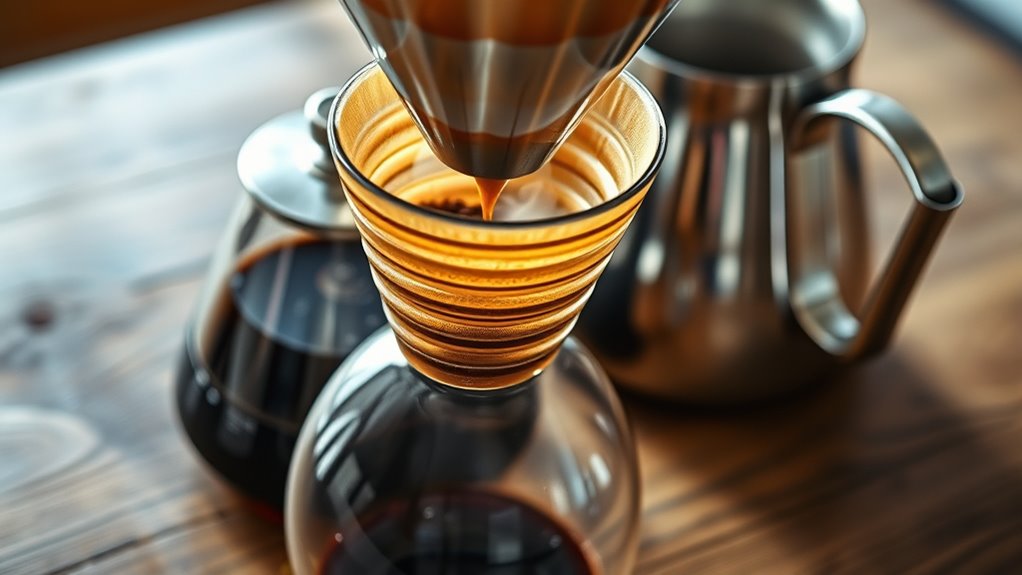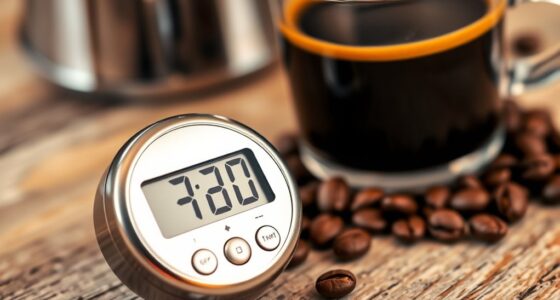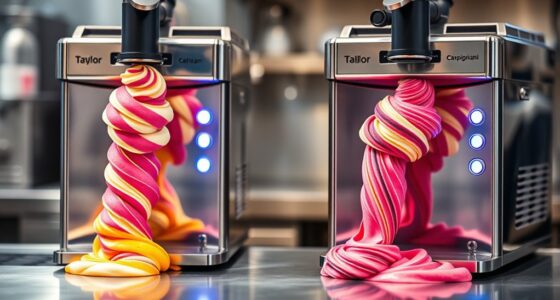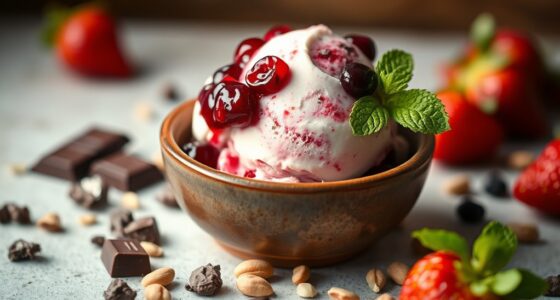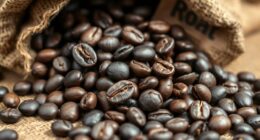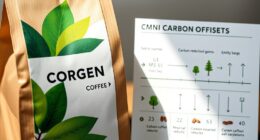Choosing a pour-over coffee maker lets you control water temperature, pour rate, and grind size, giving you a personalized brew every time. Options range from glass Chemexs to stainless steel Kalita Waves, fitting various budgets and styles. Single-cup models are perfect for quick, individual servings, while larger versions serve groups. Material impacts durability and heat retention. To make the best coffee, follow proper techniques—continue exploring to master selecting the right pour-over for your taste and needs.
Key Takeaways
- Consider material options like glass, stainless steel, porcelain, or plastic for durability, heat retention, and aesthetic appeal.
- Assess capacity needs, choosing single-cup models for personal use or multi-cup versions for serving multiple people.
- Evaluate ease of use and control features to match your skill level, from beginner-friendly to more advanced options.
- Focus on brewing variables such as water temperature and pour technique to optimize flavor and aroma extraction.
- Ensure the model is easy to clean and maintain for consistent performance and long-term durability.
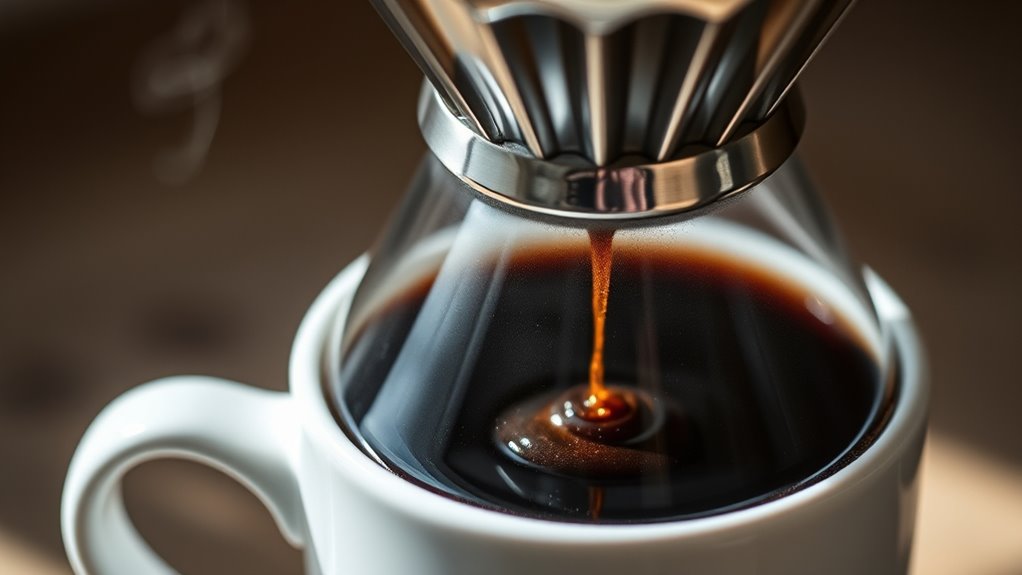
Pour-over coffee makers have gained popularity among coffee enthusiasts because they give you full manual control over the brewing process. This control lets you tweak variables like water temperature, pour rate, and coffee grind size, so you can craft a cup exactly to your taste. Unlike automatic coffee machines, pour-over brewers empower you to experiment with different brewing techniques and coffee beans, resulting in a more personalized flavor profile. Whether you prefer a bright, fruity acidity or a rich, full-bodied brew, you can adjust your process to bring out the best in your coffee beans.
One of the key benefits is the ease of cleaning. Most pour-over makers are simple to rinse or wash, often requiring just a quick rinse of the filter holder and carafe. This straightforward cleaning process helps maintain the purity of flavors and reduces buildup of coffee oils that can affect taste. Additionally, many models are compact and space-efficient, making them ideal for small kitchens, apartments, or offices. They don’t take up much storage space and are easy to transport, especially travel-friendly options like collapsible models that fold flat when not in use.
When selecting a pour-over coffee maker, you’ll want to think about the type of material used. Glass models like the Chemex are visually appealing and heat-resistant, while stainless steel options like the Kalita Wave are durable and nearly unbreakable. Porcelain and ceramic models often combine aesthetic appeal with good heat retention, adding to their appeal. Plastic variants are generally more affordable but may not last as long or retain heat as well. Your choice of material can influence the brew quality, durability, and ease of maintenance.
Capacity is another important factor. If you usually drink alone, a single-cup model might suffice, but if you want to serve multiple people or enjoy larger portions, look for a multi-cup version. Design complexity varies, with some models requiring more assembly or technique, so consider how much effort you’re willing to invest in brewing. Price ranges widely depending on brand, material, and features, so set a budget that aligns with your needs and expectations. Ease of use also matters; some models are more forgiving for beginners, while others require a bit more finesse but offer greater control.
To get the best results, follow best practices like using water between 195°F and 205°F, adjusting your coffee-to-water ratio to suit your taste, and ensuring a consistent, steady pour. Regular cleaning prevents buildup that could compromise the flavor. For specific needs, popular models like the Chemex Classic for style and capacity, Melitta for travel, Kalita Wave for durability, Hario V60 for beginner-friendliness, and Miir Pourigami for travel portability stand out.
Compared to auto-drip coffee makers, pour-over machines give you more control over every aspect of brewing, leading to richer, more nuanced cups that reflect your personal preferences.
Frequently Asked Questions
How Do I Clean and Maintain My Pour-Over Coffee Maker?
To keep your pour-over coffee maker clean and well-maintained, you should rinse it immediately after each use to prevent residue buildup. Use warm, soapy water and a soft sponge to clean the dripper and carafe, then rinse thoroughly.
Regularly soak removable parts in vinegar-water to dissolve mineral deposits, and scrub stubborn stains gently.
Store your equipment dry and inspect for damage monthly to guarantee ideal brewing and longevity.
Can I Use Any Type of Coffee Grind for Pour-Over Brewing?
Imagine you’re a barista in a vintage café, but not all coffee grinds suit your brew. You can’t just use any grind for pour-over; it needs to be specific. Medium-fine to medium-coarse works best, depending on your filter and brewer.
Using the wrong grind can lead to weak or bitter coffee. So, pick the right grind size to guarantee your pour-over tastes as good as your favorite café’s.
What’s the Ideal Water Temperature for Pour-Over Coffee?
The ideal water temperature for pour-over coffee is between 195-205°F (90-96°C).
You should aim for around 200-205°F for most medium roasts, while dark roasts do better at 195-200°F to prevent bitterness.
Using a gooseneck kettle or a temperature-controlled device helps you uphold the right heat.
Keep in mind, maintaining consistent temperature ensures balanced extraction and enhances the flavor profile of your coffee.
How Do I Troubleshoot Common Pour-Over Brewing Issues?
Troubleshooting your pour-over isn’t rocket science, but it might feel like it. If your coffee’s weak, maybe your grind’s too coarse or your water’s too cold—check those.
Over-extraction? Fines might be running wild, so use a burr grinder and watch your pour. Don’t rush! Keep your water flow steady, your water filtered, and your equipment clean.
With patience and precision, your brew will finally behave.
Are There Eco-Friendly or Reusable Filters Available?
Yes, eco-friendly and reusable filters are widely available. You can choose from materials like organic linen, cotton, compostable fabrics, or durable stainless steel. These options help reduce plastic waste, save money over time, and often improve your coffee’s flavor by allowing natural oils to pass through.
Reusable basket or pour-over filters are easy to clean with hot water or boiling, making them a sustainable and convenient choice for your coffee routine.
Conclusion
With so many options, choosing a pour-over coffee maker might feel overwhelming, but don’t let that stop you. Remember, the best machine is the one that fits your taste and lifestyle. Even if you’re new to pour-over brewing, it’s easy to learn and incredibly rewarding. So go ahead—pick a model, experiment with your favorite beans, and enjoy a fresh, flavorful cup every time. Your perfect brew is just a pour away!
